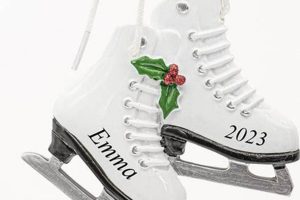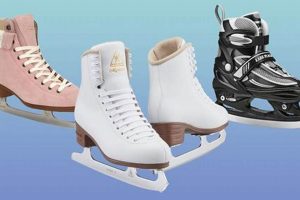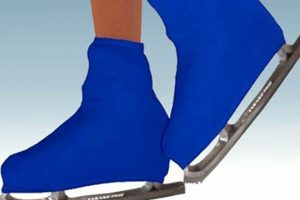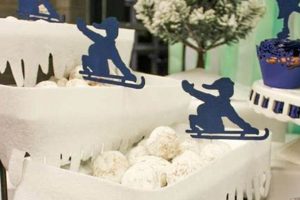Obtaining footwear designed for gliding on ice surfaces through a temporary exchange of payment is a common practice at ice rinks and recreational facilities. This arrangement provides access to specialized equipment, enabling individuals to participate in ice-based activities without the upfront cost of purchasing personal gear. For instance, a patron may visit an ice rink and, upon paying a designated fee, receive a pair of ice skates sized appropriately for their feet for a specified duration.
This service offers several advantages. It lowers the barrier to entry for participation in ice skating, making the activity accessible to a wider demographic. It eliminates the need for individuals to invest in equipment that may only be used infrequently. Furthermore, facilities often maintain and sharpen the blades, ensuring a reasonable level of performance and safety for users. Historically, such services have been integral to the popularization of ice skating as a leisure activity, facilitating widespread engagement regardless of personal equipment ownership.
The subsequent sections will delve into various aspects of this arrangement, including factors influencing cost, considerations for choosing appropriate sizing and models, facility policies regarding usage, and practical tips for ensuring a positive experience on the ice.
Essential Considerations for Ice Skate Rentals
Prior to engaging in the activity, adherence to the following guidelines can enhance safety and enjoyment when utilizing rented ice skates.
Tip 1: Assess Blade Condition: Inspect the blades for excessive rust, nicks, or dullness. Request an alternative pair if significant degradation is apparent. Compromised blades can impede maneuverability and increase the risk of falls.
Tip 2: Prioritize Proper Sizing: Ensure the skates fit snugly but not excessively tightly. Ill-fitting skates can lead to discomfort, blisters, and reduced control on the ice. Utilize the facility’s sizing chart and seek assistance from staff if needed.
Tip 3: Secure Lacing Appropriately: Lace the skates firmly, paying particular attention to the ankle area. Properly laced skates provide necessary support and prevent ankle instability. Avoid overtightening, which can restrict circulation.
Tip 4: Check for Ankle Support: Evaluate the rigidity of the skate’s ankle support. Adequate support minimizes the risk of ankle sprains or injuries, particularly for novice skaters.
Tip 5: Wear Appropriate Socks: Opt for thin, moisture-wicking socks. Thick socks can create bulkiness and hinder proper skate fit. Moisture-wicking materials help prevent blisters and maintain foot comfort.
Tip 6: Confirm Facility Policies: Familiarize oneself with the rink’s rules regarding skate usage, including designated skating areas and prohibited activities. Compliance with these policies contributes to a safer environment for all patrons.
Tip 7: Utilize Protective Gear: Consider the use of helmets and other protective gear, especially for beginners. Head injuries are a significant risk in ice skating, and helmets can mitigate the severity of potential impacts.
Diligent application of these recommendations promotes a safer and more comfortable experience when employing rented ice skates, minimizing potential hazards and optimizing enjoyment of the activity.
The subsequent section will address common issues encountered during the process and provide solutions to ensure optimal usability.
1. Availability
Availability represents a critical factor influencing the accessibility and overall viability of the temporary acquisition of ice skates. The presence or absence of suitable equipment significantly affects participation rates and the potential for individuals to engage in ice-related activities.
- Seasonal Impact on Inventory
Demand for ice skates tends to fluctuate seasonally, with higher demand during colder months and holiday periods. Facilities managing such rental services must adjust inventory levels to meet these varying demands, ensuring sufficient stock to accommodate peak periods. Failure to do so can result in patrons being unable to participate due to a lack of available skates in their size.
- Facility Capacity and Skate Quantities
The maximum number of individuals able to skate simultaneously is inherently limited by the quantity of skates available for temporary exchange. Rinks with insufficient skate inventory may experience overcrowding, diminishing the skating experience and potentially increasing safety risks. A balanced ratio of skate availability to rink capacity is essential for optimal operation.
- Maintenance Schedules and Temporary Shortages
Routine maintenance, including blade sharpening and repairs, necessitates temporary removal of skates from circulation. Efficient management of maintenance schedules is vital to minimize disruptions to availability. Extended periods of reduced availability, particularly during peak seasons, can negatively impact customer satisfaction and revenue.
- Diversity of Sizes and Models
A comprehensive offering of sizes and skate models caters to a broader range of patrons, from young children to adults with varying foot shapes and skill levels. Limited size availability disproportionately affects certain demographics, restricting their access to the activity. Similarly, a lack of specialized skates (e.g., figure skates versus hockey skates) may discourage individuals with specific skating preferences.
The interplay of these factorsseasonal demand, facility capacity, maintenance protocols, and size/model diversitycollectively determines the practical accessibility of the temporary acquisition of specialized footwear. Effective management of availability is therefore paramount to ensuring equitable access and optimizing the utilization of ice-skating facilities.
2. Sizing Accuracy
Precise sizing is paramount when temporarily acquiring ice skates. Inaccurate sizing compromises comfort, control, and safety, potentially leading to injury and a diminished user experience. The following facets elaborate on the critical relationship between appropriate sizing and the temporary acquisition of ice skating equipment.
- Foot Measurement Techniques
Accurate foot measurement is the foundation of proper sizing. Standardized foot measuring devices, such as Brannock devices, provide a reliable basis for determining the appropriate skate size. However, variations in foot width and arch height necessitate individualized assessments, exceeding the limitations of solely relying on length measurements. Failure to account for these individual foot characteristics results in improperly fitted skates.
- Skate Manufacturer Variations
Sizing conventions differ between skate manufacturers. A size 9 in one brand may not correspond precisely to a size 9 in another. This discrepancy necessitates consultation with sizing charts specific to the manufacturer of the available skates. Reliance on general sizing knowledge, without considering brand-specific variations, increases the likelihood of selecting an incorrect size.
- Impact on Performance and Injury Risk
Improperly sized skates hinder performance and elevate the risk of injury. Skates that are too large impede control, increasing the likelihood of falls. Conversely, skates that are too small constrict circulation, leading to discomfort and potential foot problems. Selection of skates that conform closely to the user’s foot dimensions optimizes control and minimizes the probability of injury.
- The Role of Professional Fitting
Professional skate fitting, performed by experienced personnel, enhances the probability of accurate sizing. Fitters possess specialized knowledge of skate construction and foot biomechanics, enabling them to identify subtle fit issues that might be overlooked by inexperienced individuals. While not always available at temporary acquisition locations, professional fitting represents the gold standard for ensuring optimal skate fit and maximizing user safety.
These elements underscore the imperative for meticulous attention to sizing when obtaining ice skates for temporary use. The ramifications of inaccurate sizing extend beyond mere discomfort, potentially impacting performance, safety, and the overall enjoyment of the activity. Responsible acquisition practices prioritize accurate measurement, consideration of manufacturer variations, and, when feasible, consultation with qualified fitters.
3. Blade Condition
The state of the blade constitutes a crucial determinant of the usability and safety of rented ice skates. Blade sharpness and integrity directly influence a skater’s ability to maintain balance, execute maneuvers, and control their movement on the ice surface. Dull or damaged blades compromise grip, increasing the likelihood of slipping and falls. Real-world examples include patrons struggling to maintain forward momentum or experiencing difficulty initiating turns due to inadequate blade edges. Therefore, blade condition is not merely a superficial aspect of renting; it is a fundamental component affecting the functionality and potential risks associated with use.
Ice rink operators are responsible for maintaining the blades of their rental stock. This maintenance typically involves regular sharpening to ensure adequate edge, as well as inspections for damage, such as nicks, rust, or excessive wear. Failure to adequately maintain blade condition creates a liability issue, as patrons may suffer injuries resulting from equipment malfunction. Furthermore, poor blade condition negatively impacts the skating experience, discouraging future rink visits and potentially damaging the facility’s reputation. Consistent monitoring and proactive maintenance are essential to mitigating these risks and ensuring customer satisfaction.
In summary, the relationship between blade condition and the temporary acquisition of specialized footwear is inextricably linked. Sharp, well-maintained blades are essential for safe and enjoyable skating, while dull or damaged blades pose significant safety risks and detract from the overall experience. Ensuring optimal blade condition represents a fundamental challenge for rental providers, requiring consistent maintenance, diligent inspection protocols, and a commitment to patron safety and satisfaction.
4. Ankle Support
Adequate ankle support is a critical factor in the safe and effective utilization of rented ice skates. The structure of an ice skate, particularly the boot portion, directly influences the stability of the ankle joint, which is essential for maintaining balance and controlling movements on the ice. Insufficient support can lead to ankle instability, increasing the risk of sprains or fractures, especially for novice skaters or those with pre-existing ankle weaknesses. For example, a skater using rented skates with compromised ankle support may find it difficult to maintain an upright posture, leading to frequent falls and potential injuries. Therefore, the integrity and design of the ankle support mechanism are paramount when obtaining ice skates for temporary use.
Rental facilities bear a responsibility to provide skates with adequate ankle support. This responsibility includes regular inspections of the boots to identify signs of wear or damage that may compromise their structural integrity. Skates with excessively softened or broken-down ankle support should be removed from circulation to prevent potential injuries to patrons. Furthermore, facilities could consider offering a range of skate models with varying levels of ankle support to accommodate different skill levels and individual needs. For instance, beginners might benefit from skates with stiffer, more supportive boots, while experienced skaters may prefer models with greater flexibility. This proactive approach to ankle support management enhances the safety and satisfaction of users.
In summary, the availability of adequate ankle support represents a non-negotiable element in the temporary acquisition of ice skates. Compromised ankle support can lead to instability, increasing the risk of injuries and detracting from the skating experience. By prioritizing the inspection and maintenance of ankle support mechanisms, and by offering a range of models to suit diverse needs, rental facilities can significantly enhance user safety and promote a more positive environment for all participants.
5. Rental Cost
The financial aspect of temporarily acquiring ice skates, commonly denoted as rental cost, plays a significant role in the accessibility and appeal of ice-skating activities. This cost directly influences an individual’s decision to participate, impacting both casual recreational skaters and those considering more frequent engagement.
- Base Rental Fee Structures
The fundamental price for a designated period, usually hourly or per session, comprises the base rental fee. This fee often varies depending on location, time of day, and the day of the week, with peak hours and weekends typically commanding higher prices. The existence of promotional discounts or group rates can also affect the final cost, providing opportunities for cost savings. For instance, a rink may offer reduced fees during weekday afternoons to attract more customers during off-peak times.
- Additional Charges and Hidden Fees
Beyond the stated base rate, supplemental charges may apply. These may include fees for skate sharpening, locker usage, or mandatory equipment such as helmets. Failure to clarify these potential surcharges beforehand can lead to unexpected expenses. Some facilities may impose late return fees, further adding to the overall rental cost. Patrons should inquire about all potential charges to avoid financial surprises.
- Impact on Participation Rates
The magnitude of the rental cost directly impacts participation rates. Elevated fees can deter price-sensitive individuals from engaging in ice-skating, particularly those who are infrequent participants or families with multiple children. Conversely, competitive or subsidized rental rates can broaden accessibility, encouraging greater participation across diverse socioeconomic groups. Cost-effectiveness serves as a crucial factor in promoting inclusivity and expanding the overall popularity of ice-skating.
- Comparative Analysis with Purchase Costs
The rental cost must be considered in relation to the alternative option of purchasing personal ice skates. For individuals who skate frequently, the cumulative rental expenses may eventually exceed the initial investment in owning a pair. The break-even point depends on factors such as rental frequency, rental rates, and the cost of purchasing comparable quality skates. This comparison informs the decision-making process, guiding individuals towards the most economically sound option based on their skating habits.
In conclusion, the economics of temporary ice skate acquisition extends beyond the nominal price. Consideration of base fees, potential surcharges, the influence on participation, and the comparative costs of ownership provides a comprehensive understanding of the financial considerations associated with engaging in this recreational activity.
6. Usage Rules
Adherence to established guidelines governing the utilization of temporarily acquired ice skates directly affects the safety and operational efficiency of ice rinks. Usage rules, whether explicitly stated or implicitly understood, dictate acceptable conduct and limitations related to rented equipment. These stipulations are not arbitrary; they serve to mitigate risks, protect property, and ensure a positive experience for all patrons. The consequences of disregarding usage rules can range from minor inconveniences to serious injuries and financial liabilities. For instance, performing prohibited maneuvers such as reckless speeding or figure skating in designated hockey areas can lead to collisions and subsequent harm. Similarly, using rental skates outside of the rink premises, such as on abrasive surfaces, can damage the blades and render the equipment unusable, resulting in repair or replacement costs for the renter.
The implementation and enforcement of usage rules are integral to risk management within ice-skating facilities. Rink operators establish these regulations to minimize potential hazards associated with shared equipment and public access to a potentially hazardous activity. Common usage rules address issues such as skate sizes, prohibited activities (e.g., carrying objects while skating), designated areas (e.g., separating beginner and advanced skaters), and responsibilities for damage or loss. Clear communication of these rules, often through signage, verbal instructions, or written agreements, is essential for ensuring compliance. Enforcement mechanisms may include warnings, suspension of skating privileges, or financial penalties for violations. The effectiveness of these measures directly impacts the overall safety and operational flow of the rink.
In summary, a direct and demonstrable link exists between usage rules and the temporary provision of specialized ice-skating footwear. These rules are not mere suggestions; they are fundamental safeguards designed to protect individuals, preserve property, and promote a harmonious skating environment. Strict adherence to and consistent enforcement of these guidelines are paramount for ensuring responsible equipment utilization and minimizing potential adverse outcomes associated with the activity. The absence of, or lax adherence to, well-defined usage rules can significantly increase the risk of accidents, injuries, and financial losses, undermining the sustainability and viability of ice-skating facilities.
Frequently Asked Questions
The following section addresses common inquiries regarding the temporary acquisition of ice skates, providing clarity on procedures, responsibilities, and potential issues.
Question 1: What factors determine the cost associated with renting ice skates?
Rental fees are contingent upon several variables. These include the duration of the rental period (hourly, daily, or per skating session), the specific location and associated overhead costs, peak demand times (weekends and holidays typically incur higher rates), and the availability of discounts or promotional offers. Additional charges may apply for skate sharpening or mandatory equipment such as helmets.
Question 2: How is the appropriate size determined when renting ice skates?
Accurate sizing is crucial for comfort and safety. Foot measurement is typically conducted using a Brannock device or similar measuring tool. Sizing charts specific to the skate manufacturer should be consulted, as sizing conventions may vary between brands. A snug fit is desirable, allowing for minimal movement of the foot within the boot while maintaining adequate circulation.
Question 3: What responsibility does the renter bear concerning the condition of the rented ice skates?
The renter is generally responsible for using the skates in a reasonable and prudent manner, adhering to all posted rink rules and guidelines. This includes avoiding actions that could damage the skates, such as skating on abrasive surfaces or engaging in reckless behavior. The renter may be held liable for significant damage or loss of the rented equipment.
Question 4: What recourse is available if the rented ice skates are defective or ill-fitting?
If the skates are found to be defective (e.g., dull blades, broken straps) or do not fit properly, the renter should immediately notify rink personnel. The facility typically provides alternative skates or a refund of the rental fee. Failure to report such issues promptly may limit available remedies.
Question 5: Are there limitations on where rented ice skates can be used?
Use of rented skates is generally restricted to the designated ice surface within the rink premises. Removal of the skates from the facility or use on surfaces other than ice is typically prohibited. Violation of these restrictions may result in additional charges or suspension of skating privileges.
Question 6: Is protective equipment provided or required when renting ice skates?
The availability and requirement for protective equipment vary by facility. Helmets are strongly recommended, particularly for novice skaters, and may be mandatory at some rinks. Knee and elbow pads may be available for optional use. Renters should inquire about the facility’s policies regarding protective equipment before commencing skating.
In summary, the temporary acquisition of ice skates necessitates careful consideration of costs, sizing, renter responsibilities, and facility regulations. Compliance with established guidelines and proactive communication with rink personnel contribute to a safe and enjoyable skating experience.
The subsequent section will provide practical tips for ensuring a positive experience on the ice.
Conclusion
This exploration of the temporary acquisition of ice skates has illuminated key factors influencing the user experience. Considerations such as cost, sizing accuracy, blade condition, ankle support, and adherence to usage rules significantly impact safety, comfort, and overall satisfaction. Proper attention to these elements ensures a more positive engagement with the activity.
Responsible utilization of this temporary acquisition system involves a commitment to informed decision-making and diligent adherence to facility guidelines. By prioritizing safety and respecting established protocols, individuals contribute to a more secure and enjoyable environment for all participants. Ongoing evaluation of rental practices and equipment maintenance is essential for sustaining the accessibility and appeal of ice-skating as a recreational pursuit.







